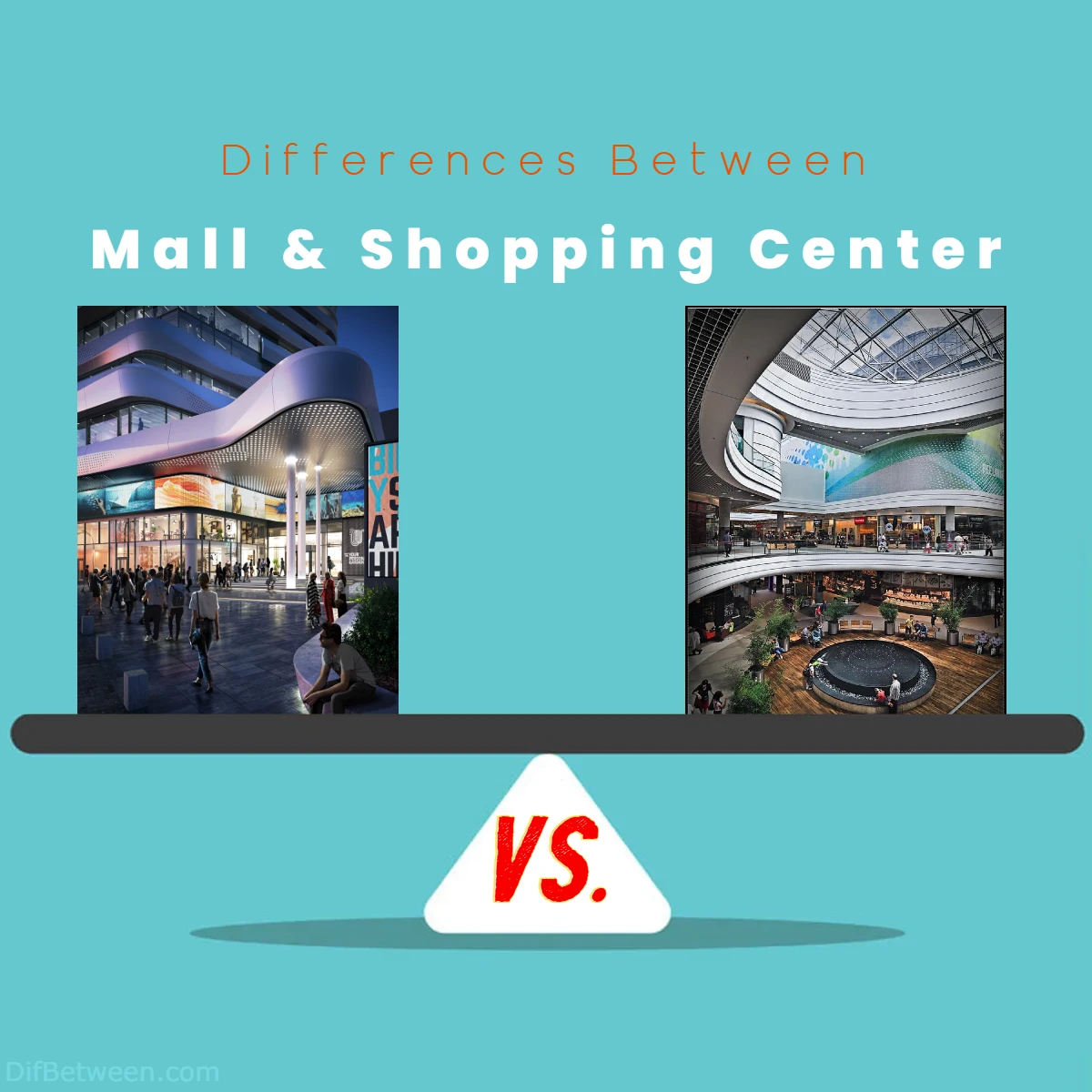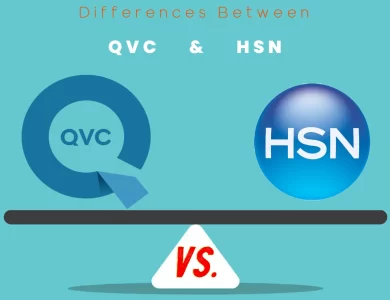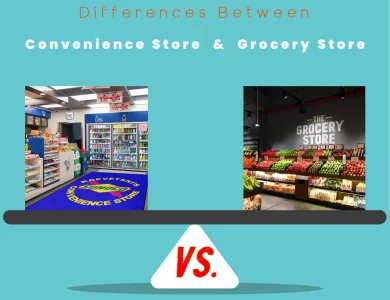
| Aspect | Mall | Shopping Center |
|---|---|---|
| Concept and Design | Extravagant retail and entertainment complex. | Pragmatic, community-oriented retail hub. |
| Size and Scale | Vast, sprawling complex with multiple floors. | Compact layout designed for community needs. |
| Architectural Style | Architectural marvel with opulent aesthetics. | Functional design prioritizing accessibility. |
| Tenant Mix | High-end luxury brands, mid-range, entertainment. | Essentials, services, and limited retail options. |
| Atmosphere and Experience | Luxurious, immersive, and sensory experience. | Cozy, familiar, and welcoming atmosphere. |
| Entertainment and Leisure | Entertainment options, theaters, indoor parks. | Cozy cafes, community events, local performances. |
| Location and Accessibility | Often located in urban centers or highways. | Situated in residential neighborhoods. |
| Marketing and Branding | Luxury branding, exclusivity, high-end campaigns. | Community-focused, convenience-driven branding. |
| Community Connection | Limited community focus, more of a destination. | Integral part of local community life. |
Step right into a world where retail realms collide and shopping dreams come to life! Are you ready to embark on a captivating journey through the enchanting realms of Malls and Shopping Centers? Prepare to unravel the threads that weave the tapestry of shopping experiences like never before. Picture the grandeur of a Mall, where luxury boutiques beckon with their opulent displays, and entertainment options abound to whisk you away into a world of wonder. On the flip side, envision the cozy charm of a Shopping Center, where the heartbeat of the community thrives, offering everyday essentials and a warm, inviting atmosphere.
Differences Between Mall and Shopping Center
The main differences between a Mall and a Shopping Center lie in their design, tenant mix, atmosphere, and purpose. Malls are extravagant retail and entertainment complexes, often featuring luxury brands, entertainment options, and a luxurious ambiance. On the other hand, Shopping Centers are community-oriented hubs, focused on convenience and everyday needs, housing essentials like grocery stores and pharmacies. While malls emphasize opulence and entertainment, shopping centers prioritize practicality and a cozy atmosphere. In essence, the choice between a Mall and a Shopping Center boils down to whether you seek a lavish shopping experience or a neighborhood-centric convenience.
1. Concept and Design: Where Form Meets Function
Mall: A Culmination of Extravaganza
Malls, often referred to as shopping malls, are grandiose retail utopias that embody opulence and allurement. They are architectural marvels that blend shopping with leisure and entertainment, creating a space where retail therapy intertwines with leisurely pursuits. Malls are designed as sprawling complexes, incorporating numerous anchor stores, boutique outlets, dining options, and entertainment venues under one opulent roof. Their layout is often meticulously planned to create an enchanting ambiance, with well-manicured corridors adorned with fountains, greenery, and sculptures.
The essence of a mall’s allure lies in its extravagant vibe and the immersive experience it offers. Visitors are welcomed into a world of luxury, where shopping is just one facet of the grand scheme. The combination of upscale brands, upscale dining, and upscale recreational activities is woven together to create a multifaceted experience.
Shopping Center: The Community Nexus
Conversely, a shopping center is a more pragmatic and community-oriented retail haven. While it doesn’t boast the grandeur of a mall, a shopping center’s design centers around functionality and convenience. Shopping centers are often smaller in scale compared to malls and prioritize easy access to stores and services. These centers are strategically located to serve specific neighborhoods or communities, aiming to provide a comprehensive selection of essentials, services, and a modest range of retail outlets.
The design philosophy of a shopping center revolves around accessibility and convenience. It’s not uncommon to find grocery stores, pharmacies, and everyday services at the heart of a shopping center. This makes it an integral part of the community’s day-to-day life, catering to essential needs in a straightforward and efficient manner.
2. Tenant Mix: The Retail Tapestry
Mall: Opulence and Diversity
Malls shine brightly in their impressive tenant mix, bringing together a spectrum of brands ranging from high-end luxury to mid-range and affordable options. The tenants in malls often include international luxury brands, fashion boutiques, electronics emporiums, and more. This curated blend ensures that shoppers have access to an expansive array of choices, be it for fashion, gadgets, or cosmetics. Malls pride themselves on offering a premium shopping experience, making them a destination for both shopping enthusiasts and those seeking lavish experiences.
| Tenant Types | Examples |
|---|---|
| Luxury Fashion Brands | Gucci, Prada, Louis Vuitton |
| Mid-Range Retailers | Zara, H&M, Forever 21 |
| Electronics Retailers | Apple Store, Samsung Experience |
| Fine Dining Restaurants | The Cheesecake Factory, Nobu |
| Entertainment Venues | Movie Theaters, Bowling Alleys |
Shopping Center: Community Connection
Shopping centers cater to the needs of local communities, reflecting a tenant mix that focuses on essentials and day-to-day necessities. While shopping centers may still include retail outlets, the emphasis here is on convenience and practicality. Expect to find grocery stores, pharmacies, banks, and perhaps a handful of apparel and accessory stores. The aim is to provide an all-encompassing experience that helps residents meet their basic needs without the glitz and glamour of luxury shopping.
| Tenant Types | Examples |
|---|---|
| Grocery Stores | Kroger, Tesco, Walmart |
| Pharmacies | CVS, Boots, Walgreens |
| Local Eateries | Sandwich Shops, Cafés |
| Apparel Retailers | Target, JC Penney, Primark |
| Everyday Services | Hair Salons, Dry Cleaners |
3. Atmosphere and Experience: Captivating All Senses
Mall: Extravagance Personified
The moment you step into a mall, you’re transported into a realm of extravagance. Malls are designed to offer a comprehensive sensory experience, from the sophisticated décor to the ambient lighting that casts a warm glow on every corner. The architecture often features awe-inspiring atriums, elegant sculptures, and intricate details that add to the luxurious atmosphere. The goal is to make shoppers feel like they’re indulging in more than just a shopping spree – it’s an experience of opulence and delight.
To enhance this experience, malls often host events, exhibitions, and entertainment shows. Concerts, fashion shows, and even art exhibitions are not uncommon, making a trip to the mall a cultural affair. The lavish food courts and fine-dining establishments amplify the grandeur, ensuring that every aspect of a visitor’s senses is catered to.
Shopping Center: Neighborly Comfort
Shopping centers, on the other hand, embrace a more cozy and familiar atmosphere. The emphasis is on creating a space that’s comfortable and welcoming, where residents can complete their everyday errands with ease. The decor might be simpler, yet it’s designed to be inviting. Think of shopping centers as the dependable neighborhood hub – a place where you can quickly pop in for groceries, get a prescription filled, and perhaps grab a coffee on your way out.
While the experience might not be as extravagant as a mall, shopping centers are often designed to encourage social interaction. Bench seating, small gathering spaces, and community events like farmer’s markets foster a sense of togetherness. It’s about being part of a local ecosystem, where convenience and familiarity reign supreme.
4. Entertainment and Leisure: A Diverse Spectrum
Mall: Beyond Shopping
Malls are not merely retail centers; they’re also entertainment hubs. Beyond the multitude of shops, malls offer a plethora of entertainment options that aim to cater to diverse preferences. From state-of-the-art movie theaters to expansive indoor theme parks, the entertainment options within malls are designed to captivate visitors of all ages. Gaming arcades, virtual reality experiences, and even ice-skating rinks contribute to the sense of escapism and amusement that malls bring to the table.
Furthermore, malls often house extravagant dining establishments that offer not just food but an experience in itself. Visitors can savor delectable cuisine in lavish settings, often surrounded by stunning views or immersive interior designs. This synergy of shopping and entertainment transforms a mall visit into an unforgettable outing.
Shopping Center: Simple Pleasures
While shopping centers might not boast the same level of extravagant entertainment options as malls, they cater to a different kind of leisurely pursuit. Think of shopping centers as places to relax, unwind, and enjoy simple pleasures. Many shopping centers feature cozy cafés, where you can grab a cup of coffee and read a book, all within arm’s reach of the stores you need. Some centers also incorporate green spaces or outdoor seating, providing a tranquil environment to take a breather.
While shopping centers might not have large-scale entertainment attractions, they often have community-driven events that create a convivial atmosphere. From seasonal fairs to local performances, these events reflect the spirit of the neighborhood and provide a platform for residents to come together and celebrate.
5. Location and Accessibility: Finding Your Way
Mall: Destinations of Choice
Malls are often strategically located in bustling urban centers or as standalone structures along major highways. Their aim is to draw visitors from various neighborhoods and even neighboring cities. This strategic placement ensures that people are willing to travel the extra mile to indulge in the opulent experience that malls offer. The grandeur of malls makes them worthy of being standalone destinations, with a trip to the mall often being an outing in itself.
Shopping Center: Neighborhood Convenience
Shopping centers, as community-focused hubs, are typically situated within residential neighborhoods or suburban areas. The objective is to provide residents with easy access to essential services and retail outlets. The proximity of shopping centers to residential areas ensures that residents can complete their shopping errands without venturing far from home. This emphasis on convenience aligns with the practical nature of shopping centers, making them an integral part of everyday life.
6. Size and Scale: From Grand to Cozy
Mall: Monumental Proportions
One of the most striking differences between malls and shopping centers lies in their size and scale. Malls, known for their grandeur, are sprawling complexes that often encompass vast square footage. These architectural marvels can span multiple floors, featuring countless corridors and wings, creating a labyrinth of luxury and commerce. The scale of malls allows for an extensive array of shops, dining options, and entertainment venues, giving visitors the feeling of wandering through a retail wonderland.
The sheer size of malls also allows for creative architectural elements such as expansive atriums, towering ceilings, and intricate interior designs. This grand scale adds to the sense of opulence and grandeur that malls exude, making each visit a journey through a world of extravagance.
Shopping Center: Compact Convenience
In contrast, shopping centers embrace a more compact and manageable size. These centers are designed to cater to the immediate needs of the community they serve, which often translates to a more concise layout. Shopping centers may consist of a single building or a smaller cluster of interconnected structures, focusing on optimizing space for efficiency and accessibility.
The smaller scale of shopping centers doesn’t diminish their significance; instead, it highlights their practicality and convenience. With fewer options to navigate, visitors can quickly find the stores and services they need without the need for extensive exploration. This streamlined approach aligns with the community-centric nature of shopping centers, making them an ideal solution for daily errands.
7. Architectural Style: Elegance vs. Functionality
Mall: Architectural Showpieces
Malls often stand as architectural showpieces, featuring designs that leave a lasting impression. These structures are meticulously planned to evoke a sense of wonder and sophistication. Atriums adorned with grand chandeliers, marble floors, and intricate mosaics create an environment that feels more like a palatial escape than a mere shopping destination. The fusion of stunning aesthetics and functionality is a hallmark of mall architecture.
The architectural designs of malls can vary widely, from modern and futuristic to classical and elegant. The goal is to create an atmosphere that resonates with the upscale brands and high-end experiences they offer. The architecture becomes an extension of the shopping experience, enveloping visitors in an environment that feels extraordinary.
Shopping Center: Practicality Reigns
Shopping centers prioritize functionality and efficiency in their architectural designs. The focus is on creating a space that serves as a hub for essential services and everyday shopping needs. This often translates to straightforward layouts, easy navigation, and a design that emphasizes accessibility.
While the architectural style of shopping centers might not be as extravagant as that of malls, it’s intentionally tailored to suit the needs of the local community. This practical approach ensures that visitors can complete their errands without unnecessary frills, making the shopping center an indispensable part of their daily routine.
8. Marketing and Branding: Luxury vs. Community
Mall: Luxury Branding
Malls are renowned for their luxury branding and marketing strategies. The opulent environment, upscale tenant mix, and lavish amenities all contribute to a sense of exclusivity and prestige. Malls often employ high-end marketing campaigns, collaborating with luxury brands to create a perception of sophistication and affluence. These campaigns may involve fashion shows, celebrity endorsements, and limited-edition releases, all aimed at maintaining the aura of opulence.
The branding of malls extends beyond shopping; they position themselves as lifestyle destinations that offer not just products, but an entire experience. This emphasis on luxury branding plays a significant role in attracting a discerning clientele seeking upscale products and services.
Shopping Center: Community Connection
Shopping centers take a different approach to branding, focusing on their role as essential community hubs. The marketing strategies employed by shopping centers revolve around convenience, affordability, and practicality. These centers often highlight their proximity to residential areas, emphasizing their role as a place where residents can quickly access everyday necessities.
Community engagement is a key aspect of shopping center branding. Events, promotions, and initiatives are geared toward fostering a sense of belonging and togetherness. This branding approach aligns with the core values of shopping centers: serving the needs of the local community and becoming an integral part of their daily lives.
FAQs
The main difference lies in their design and purpose. Malls are extravagant complexes that blend shopping, entertainment, and luxury, while Shopping Centers are community-focused hubs catering to convenience and essential needs.
Malls showcase a diverse range of brands, including luxury, mid-range, and entertainment options. In contrast, Shopping Centers prioritize essentials like grocery stores, pharmacies, and local services.
Malls offer an opulent and immersive experience with upscale aesthetics and entertainment options. Shopping Centers provide a cozy, community-oriented ambiance that focuses on familiarity and convenience.
Yes, but the scale differs. Malls often host large entertainment venues like theaters and indoor parks. Shopping Centers offer simpler pleasures such as cafes, local events, and community gatherings.
Malls boast impressive architectural designs, often grand and luxurious. Shopping Centers prioritize functionality and accessibility, offering a straightforward layout for ease of navigation.
A Shopping Center is better suited for everyday needs, with its focus on convenience and essentials. It’s a hub for grocery shopping, pharmacies, and local services that cater to your daily routine.
Malls are often found in urban centers or along major highways, drawing visitors from various areas. Shopping Centers are strategically located within residential neighborhoods, providing easy access to nearby communities.
Yes, but the nature of the events differs. Malls may host large-scale events like concerts and fashion shows. Shopping Centers emphasize local engagement, featuring events like farmer’s markets and neighborhood performances.
Malls often focus on luxury branding, exclusivity, and high-end campaigns. Shopping Centers prioritize convenience and community connection in their branding, highlighting their role as local hubs.
The choice depends on your preferences. If you’re seeking luxury, entertainment, and an immersive experience, a Mall might be your choice. If you prioritize convenience, community engagement, and everyday needs, a Shopping Center could be your go-to destination.
Read More:
Contents
- Differences Between Mall and Shopping Center
- 1. Concept and Design: Where Form Meets Function
- 2. Tenant Mix: The Retail Tapestry
- 3. Atmosphere and Experience: Captivating All Senses
- 4. Entertainment and Leisure: A Diverse Spectrum
- 5. Location and Accessibility: Finding Your Way
- 6. Size and Scale: From Grand to Cozy
- 7. Architectural Style: Elegance vs. Functionality
- 8. Marketing and Branding: Luxury vs. Community
- FAQs






